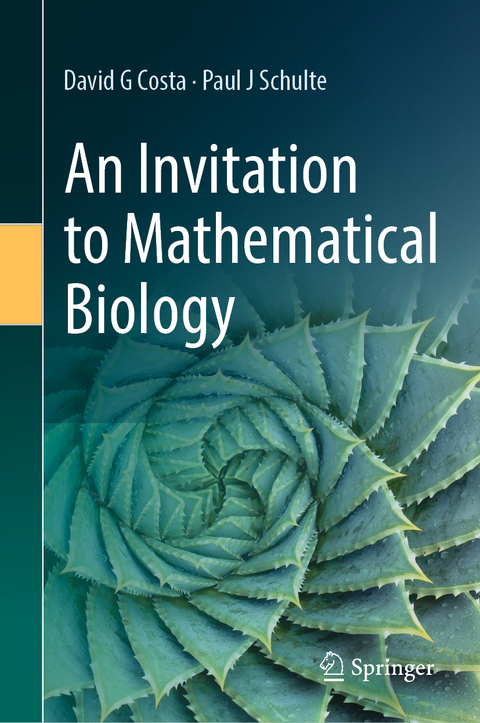
An invitation to mathematical biology
Springer International Publishing (Verlag)
978-3-031-40257-9 (ISBN)
lt;b>David G Costa is a mathematician interested in Partial Differential Equations (PDEs), Ordinary Differential Equations (ODEs) and the Calculus of Variations. In particular, he is interested in the use of so-called variational and topological techniques to study qualitatively and visualization of phenomena in PDEs and ODEs. Such phenomena are present in various areas of sciences, including physics, biology, and chemistry, among others. He teaches a variety of courses at the undergraduate level (including Calculus, Linear Algebra, ODEs, PDEs, and Introductory Real Analysis), and graduate level (including PDEs, and Real Analysis), as well as a course in Biomathematics jointly offered by the Department of Mathematical Sciences and School of Life Sciences.
Paul J Schulte is a plant physiologist interested in biophysical approaches to studying internal processes in plants. These commonly involve applications of mathematical approaches as realized through computational solutions. Plants are dependent on water for survival and their ability to acquire water from the soil and transport it throughout the plant is determined in part by the hydraulic properties of the plant's tissues. Most of his work considers transport processes such as water flow in the xylem tissues or sugar flow in the phloem tissues. He teaches a variety of courses such as Plant Physiology, Plant Anatomy, Introduction to Biological Modeling, and Biomathematics jointly offered in the School of Life Sciences and Department of Mathematical Sciences.
lt;p>Preface
1 Introduction
2 Exponential Growth and Decay
2.1 Exponential Growth
2.2 Exponential Decay
2.3 Summary
2.4 Exercises
2.5 References
3 Discrete Time Models
3.1 Solutions of the discrete logistic
3.2 Enhancements to the Discrete Logistic Function
3.3 Summary
3.4 Exercises3.5 References
4 Fixed Points, Stability, and Cobwebbing4.1 Fixed Points and Cobwebbing
4.2 Linear Stability Analysis
4.3 Summary
4.4 Exercises
4.5 References
5 Population Genetics Models
5.1 Two Phenotypes Case
5.2 Three Phenotypes Case
5.3 Summary
5.4 Exercises
5.5 References
6 Chaotic Systems
6.1 Robert May's Model
6.2 Solving the Model
6.3 Model Fixed Points
6.4 Summary
6.5 Exercises
6.6 References
7 Continuous Time Models
7.1 The Continuous Logistic Equation
7.2 Equilibrium States and their Stability
7.3 Continuous Logistic Equation with Harvesting
7.4 Summary
7.5 Exercises
7.6 References
8 Organism-Organism Interaction Models
8.1 Interaction Models Introduction
8.2 Competition
8.3 Predator-Prey
8.4 Mutualism
8.5 Summary
8.6 Exercises
8.7 References
9 Host-Parasitoid Models
9.1 Beddington Model
9.2 Some Solutions of the Beddington Model
9.3 MATLAB Solution for the Host-Parasitoid Model
9.4 Python Solution for the Host-Parasitoid Model
9.5 Summary
9.6 Exercises9.7 References
10 Competition Models with Logistic Term
10.1 Addition of Logistic Term to Competition Models
10.2 Predator-Prey-Prey Three Species Model
10.3 Predator-Prey-Prey Model Solutions
10.4 Summary.
10.5 Exercises
10.6 References
11 Infectious Disease Models
11.1 Basic Compartment Modeling Approaches
11.2 SI Model
11.3 SI model with Growth in S
11.4 Applications using Mathematica
11.5 Applications using MATLAB
11.6 Summary.
11.7 Exercises11.8 References
12 Organism Environment Interactions
12.1 Introduction to Energy Budgets
12.2 Radiation
12.3 Convection12.4 Transpiration
12.5 Total Energy Budget
12.6 Solving the Budget: Newton's Method for Root Finding
12.7 Experimenting with the Leaf Energy Budget
12.8 Summary
12.9 Exercises
12.10 References
13 Appendix 1: Brief Review of Differential Equations in Calculus
14 Appendix 2: Numerical Solutions of ODEs
15 Appendix 3: Tutorial on Mathematica
16 Appendix 4: Tutorial on MATLAB
17 Appendix 5: Tutorial on Python Programming
Index
"I think the authors have succeeded in their goal of providing an 'invitation' to mathematical biology. Not only can this book serve as a stepping stone to more comprehensive mathematical biology books, it also offers the reader a glimpse into a variety of topics that they can pursue in deeper detail later on if they are interested." (Anita T. Layton, SIAM Review, Vol. 66 (3), August, 2024)
| Erscheinungsdatum | 04.10.2023 |
|---|---|
| Zusatzinfo | Illustrationen |
| Verlagsort | Cham |
| Sprache | englisch |
| Maße | 155 x 235 mm |
| Gewicht | 331 g |
| Einbandart | gebunden |
| Themenwelt | Mathematik / Informatik ► Informatik ► Theorie / Studium |
| Medizin / Pharmazie ► Allgemeines / Lexika | |
| Naturwissenschaften ► Biologie | |
| Schlagworte | Biological Systems • Computational • differential equation • Mathematical Modeling • MATLAB • Numerical |
| ISBN-10 | 3-031-40257-X / 303140257X |
| ISBN-13 | 978-3-031-40257-9 / 9783031402579 |
| Zustand | Neuware |
| Informationen gemäß Produktsicherheitsverordnung (GPSR) | |
| Haben Sie eine Frage zum Produkt? |
aus dem Bereich


